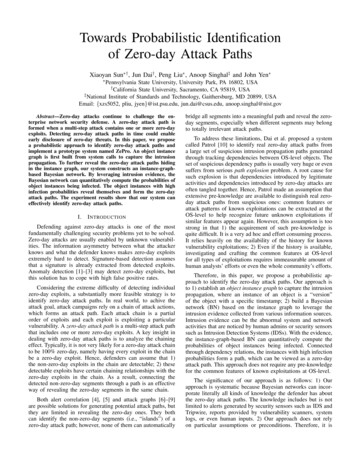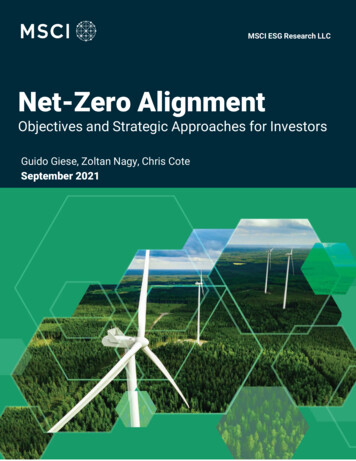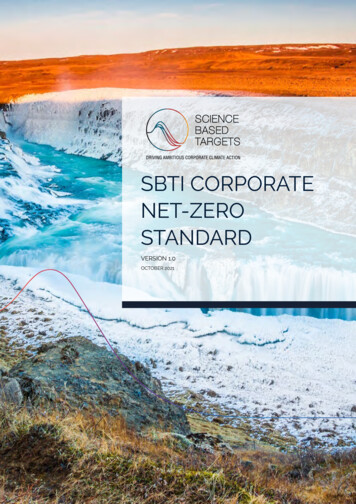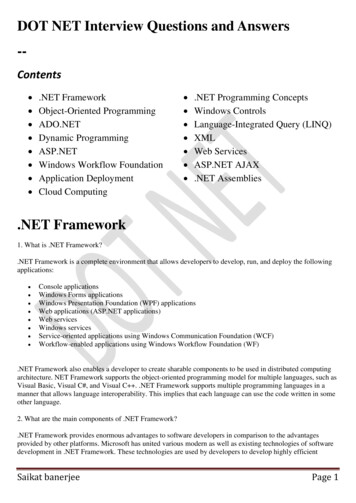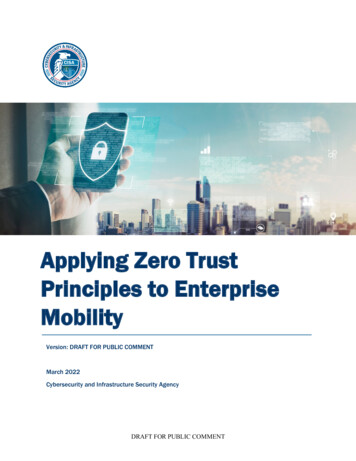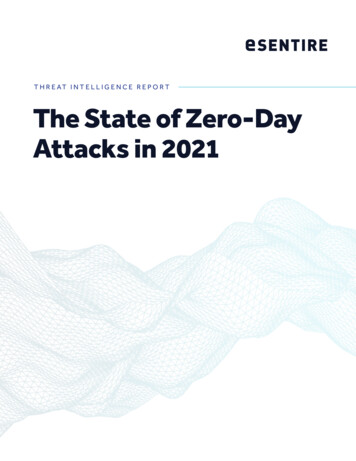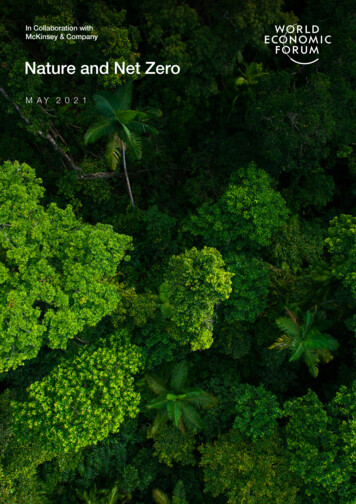
Transcription
In Collaboration withMcKinsey & CompanyNature and Net ZeroM AY 2 0 2 1
Cover: Getty ImagesContentsForeword3Executive summary4Introduction: converging crises and the need for a sustainable recovery51 New commitments: corporate climate action is acceleratinginvestments in nature72 Nature: the key to achieving net zero103 The way forward: unlocking the potential of natural climate solutions193.1 Key Action #1: Define net zero and corporate claims213.2 Key Action #2: Highlight good practice for supply223.3 Key Action #3: Send a demand signal243.4 Key Action #4: Improve market architecture263.5 Key Action #5: Create regulatory clarity283.6 Build trust314 Conclusion33Contributors34Endnotes35 2021 World Economic Forum. All rightsreserved. No part of this publication maybe reproduced or transmitted in any formor by any means, including photocopyingand recording, or by any informationstorage and retrieval system.Consultation: Nature and Net Zero2
January 2021Consultation: Nature and Net ZeroForewordBill WintersChief Executive Officer,Standard CharteredAs the world starts to look beyond the COVID-19pandemic, there is a compelling case to addressthe climate crisis in the context of the globalrecovery and reconstruction effort. Awareness isgrowing, across businesses and among citizens,that tackling climate change is inextricably linked toanother urgent environmental crisis: the acceleratingdestruction of nature. Natural climate solutions (NCS)– investment in conservation and land managementprogrammes that increase carbon storage andreduce carbon emissions – offer an important way ofaddressing both crises simultaneously.Greenhouse gas emissions from agriculture, forestryand other land use contribute to about a quarter ofglobal emissions, and it is estimated that NCS projectscan help deliver around one-third of net emissionreductions needed by 2030. However, despite theirvast potential for reducing emissions, natural climatesolutions attract very little public investment.I welcome this report by the World EconomicForum and McKinsey exploring the opportunitiesand challenges involved in NCS. It builds onthe work of the Taskforce on Scaling VoluntaryCarbon Markets, which I am pleased to Chairand whose final report setting out a blueprintfor infrastructure and mechanisms to achieverapidly rising investment in nature was publishedon 25 January. Together, these documentsprovide clear and detailed guidance on the rolebusiness can play in curbing climate change,through making commitments to align with theParis Agreement; reporting annually on theiremissions and those produced in their value chainsusing accepted standards; and compensatinga share of unabated emissions through thepurchase and retirement of carbon credits.Natural climate solutions are crucial tools in thistransition process, provided they are underpinnedby internationally accepted principles and rulesto ensure that they genuinely deliver emissionreductions/sequestration, and to increase publicacceptance of carbon offsetting as a vital element ofthe climate transition. This cannot be at the expenseof accelerating decarbonization of business models.We need to drive adoption of available solutions andalso invest in new technologies that create viableoptions for hard-to-abate sectors.This report sheds light on the significant co-benefitsof NCS to nature and humanity. Carbon marketparticipants are increasingly recognizing thesebroader benefits. Not least of these is the flow ofprivate capital they can generate to countries thatoffer the highest potential for NCS projects, typicallyforest-rich countries in the Global South.The report shows how NCS are being preventedfrom fulfilling their potential at scale by conceptualand technical hurdles. The lack of consensus onhow to treat corporate carbon reduction claimsand on the role that NCS can play needs to beaddressed. Agreement is required on standardsand certification under one commonly acceptedinternational standards body. Continuing publicconcerns about the validity of NCS credits shouldbe addressed through highlighting and sharingbest practice. I see this work, alongside that of theTaskforce on Scaling Voluntary Carbon Markets,as a call to action on the part of all stakeholders totackle these hurdles.I look forward to seeing stakeholders respond to thischallenge by charting a course to realize a significantincrease in investment in nature. This year, as weprepare for COP26, is the time for action.Consultation: Nature and Net Zero3
Executive summaryNatural climate solutions offer an opportunityto address both climate and nature crises andgenerate significant additional environmental,social and economic benefits.–The world faces converging environmentalcrises that are inextricably linked andcompounding: the accelerating destructionof nature and climate change. Natural climatesolutions (NCS) offer an opportunity to addressboth and generate significant additionalenvironmental, social and economic benefits.–Private-sector commitment to action is gainingmomentum, with many companies setting thegoal of reaching net-zero emissions and somealso making commitments on nature. As a result,NCS are gaining attention and carbon marketsare growing fast. Corporate strategies that aimto use NCS to help deliver a net-zero pathwayare on the verge of becoming mainstream.–NCS are fundamental to delivering a net-zeropathway alongside rapid decarbonization, byenabling avoidance/reduction of emissions, andremoval/sequestration of carbon dioxide fromthe atmosphere.–Reaching a 1.5 or 2 C pathway by 2030 willrequire about a 50% net-emission reductionof annual emissions to around 23 gigatons ofcarbon dioxide (Gt CO2) from 2019 levels.–We estimate a practical potential of close to7Gt CO2 per year from NCS projects, sufficientto deliver around one-third of that target and toachieve carbon removal in the near term and atlower cost than technological solutions. The bulkof this total comprises four types of NCS: avoideddeforestation and peatland impact, peatlandrestoration, reforestation and cover crops.–NCS are typically low-cost sources of carbonabatement. In most cases, costs are between 10 and 40 per ton of CO2 with variationsbetween geographies and project types.–Beyond helping to address the changing climate,NCS can also deliver significant co-benefits tonature and humanity, and can generate privatecapital flows to countries that offer the highestpotential for NCS projects, typically forest-richcountries in the Global South.–However, NCS are being held back from fulfillingtheir potential at scale by various conceptualand technical hurdles, starting with a lack ofconsensus on how to treat corporate carbonreduction claims and on the role that NCS canplay. Agreement is needed on standards andcertification under one commonly acceptedinternational standards body. Continuing publicconcerns about the validity of NCS creditsshould be addressed through highlighting andsharing best practices.–To overcome years of oversupply of carboncredits and low prices, a demand signal isneeded to build confidence and unlock thesupply pipeline of potential NCS projects.–Market architecture, infrastructure and financingneed to be developed to support the growthof NCS producing tradable credits, as set outin the recent report of the Taskforce on ScalingVoluntary Carbon Markets (TSVCM).–Finally, it is vital to build coherent and agreedpolicy frameworks at either the national orinternational level for the growth of NCS in linewith climate goals, covering such issues ascarbon standards, rules on accounting at thejurisdictional or project level, and connectingvoluntary and compliance markets.–This demands a concerted effort to build trustand a broad consensus on the value of NCS toaddress the lack of confidence in the integrity ofNCS credits, the markets, and the institutionsthat govern them. On the one hand, there is aneed to increase public awareness, while onthe other, it is critical to create multistakeholdercommunities of trust to air and addressconceptual differences.Consultation: Nature and Net Zero4
Below: Getty ImagesIntroduction: convergingcrises and the need fora sustainable recoveryNCS should be an integral component ofeconomic strategies to ensure a “greenrecovery” from the ravages of COVID-19.Consultation: Nature and Net Zero5
As the world emerges from the health andeconomic crises caused by COVID-19, we faceconverging environmental crises: the acceleratingdestruction of nature and climate change. Thesecrises are inextricably linked and compounding.Although the benefits are often hidden, naturesustains over half of the global economy – itensures food security and supports water cycles;it protects communities from floods, fires anddisease; and it helps mitigate climate change byabsorbing carbon dioxide, and, in some cases,providing resilience against the impacts of climatechange.1 But this stock of natural assets, theplanet’s balance sheet, is finite and dwindling. Theneed for action is pressing: 32% of the world’sforests have been destroyed, 40% of invertebratepollinators face extinction, and there has been a23% reduction in land surface productivity due toland degradation.2 This drawdown on natural capitalis unsustainable, accelerating climate change,reducing resiliency and broadening challenges tothe availability of fresh water, clean air, fertile soiland abundant biodiversity.The followingdiscussion papersets out anaction agendato accelerate thescale-up of highquality NCS andunlock marketsthrough thecombined effortsof businessleaders, policymakers andcivil society.BOX 1Meanwhile, climate change is having a substantialimpact across the world – and is likely to increasein a non-linear fashion. Rising temperatures,disrupted water supplies and flooding will displacetens of millions of people. While today there aretens of millions of environmental migrants, by2050 approximately one billion people will live incountries that do not have the resilience to deal withexpected ecological changes.3Drought and extreme weather events will threatenfood production and supply chains. In 2020 alone,fires ravaged multiple countries. In Australia, one-fifthof the continent’s entire temperate broadleaf andmixed forest biome was destroyed;4 in California,wildfires burned more land in 2020 than any year onrecord – nearly five times the five-year average;5 Brazil,Ukraine and Russia also suffered extensive fires.The Paris Agreement is unequivocal: If we are tosignificantly reduce the risks and impacts of climatechange, we must hold the increase in the globalaverage temperature to well below 2 Celsius abovepre-industrial levels and endeavour to limit thetemperature increase to 1.5 C.6This report outlines the potential for NCS toaddress the converging crises of climate changeand nature loss, while also helping to deliversustainable development in line with the UnitedNations Sustainable Development Goals (SDGs) –providing equitable livelihoods, advancing educationand equality, and improving natural resourcemanagement. With close to 7Gt CO2 in annualpotential by 2030, assuming an illustrative priceper ton of 20 would suggest potential capitalflows greater than 100 billion, with opportunityacross the world, especially in the Global South.7Consequently, nature more broadly, and NCSspecifically, should be an integral component ofeconomic strategies to ensure a “green recovery”from the ravages of COVID-19.This research should be seen within the broadercontext of the need to scale investment in climateand nature, as described recently by the Taskforceon Scaling Voluntary Carbon Markets (TSVCM) andthe World Economic Forum’s New Nature Economyreport series. The following discussion paper setsout an action agenda to accelerate the scale-up ofhigh-quality NCS and unlock markets through thecombined efforts of business leaders, policy-makersand civil society. This first consultation paper seeksto create discussion with stakeholders on the roleof NCS to mitigate both climate and nature crises,as well as appropriate implementation strategies tobuild trust and confidence in the market.About natural climate solutionsNatural climate solutions (NCS) are “conservation,restoration and improved land managementactions that increase carbon storage and/oravoid greenhouse gas emissions”.8 NCS thereforeplay a role in avoiding/reducing emissions by, forinstance, avoiding deforestation, and removing/sequestering emissions such as through restoringpeatlands as part of climate-mitigation pathways.Ability to mitigateclimate changeNCS have environmental and financial attractions.Many NCS have low costs compared toother climate mitigation options, as well asenvironmental, social and economic co-benefitssuch as safeguarding biodiversity, securing watersupplies and providing jobs for local communities.Environmental,social and ion: Nature and Net Zero6
Below: Getty Images1New commitments:corporate climateaction is acceleratinginvestments in natureConsultation: Nature and Net Zero7
The call is beingheard: Net-zerocommitments bycompanies havemore than doubledin the past year andthe scale of NCSand offset pledgeswithin thesecommitments isrising accordingly.Private-sector commitment to climate action isgaining momentum. Many companies are settingnet-zero goals to drive low-carbon strategies andaddress the business risks and opportunities theyface. Risks include those across their value chain –disrupted supply chains and volatile prices of rawmaterials, for example – resulting from extremeweather events and other climate effects (physicalrisks), as well as regulatory and reputational risksthat arise through shifts to greener economies(transition risks).9 Their customers are meanwhiledemanding climate-friendly products and services,presenting companies that are perceived to fail toact with potential loss of business. Investors aredemanding action as well: In his 2020 CEO letter,Larry Fink, chief executive officer of BlackRock,wrote, “Every government, company, andshareholder must confront climate change”, in a callto action from the world’s largest asset managerwith almost 8 trillion under management.10The call is being heard: Net-zero commitments bycompanies have more than doubled in the pastyear and the scale of NCS and offset pledges withinthese commitments is rising accordingly.11 Basedon net-zero commitments today from more than700 of the world’s largest companies, there havealready been commitments of around 0.2Gt CO2of carbon credits by 2030.12 For instance, industry-level action in the aviation and oil and gas sectorshas accelerated commitments to net zero, withAmerican Airlines, Shell and bp among those withnet-zero pledges.The actual demand for carbon credits based on acompany’s commitments is intricately linked withthe claims a company is able to make. Today, thosemaking net-zero claims are expected to reduce theiremissions where possible, and neutralize by retiringan equivalent amount of carbon credits or investingdirectly in carbon removals. The precise definitionand requirements of various claims are not yet clear(see Key Action #1). The ambition of these claimsvaries across companies. For example, Microsofthas set a high bar by committing to remove allhistorical emissions since its inception in 1975.Alongside the potential use of NCS to satisfydemand for carbon credits, leaders are alsoinvesting directly in nature. For example, Amazonis investing 10 million to restore 1.6 millionhectares (Mha) of forest in the United States,Nestlé is investing in ending deforestation andforest restoration in Ghana and Côte d’lvoire, andShell is planting 5 million trees in the Netherlands,among other climate commitments.13 Walmart haspledged to be net zero in operations by 2040, andto manage or restore 50 million acres of land andConsultation: Nature and Net Zero8
1 million square miles of ocean. Within their netzero commitments, companies such as Unileverand PepsiCo have committed specifically to NCS,recognizing the importance of engaging with farmersand growers across the value chain who are criticalto protecting and restoring landscapes and forests.the Biden administration adopts a net-zero target,50% of the top 10 emitters will have done so.In sum, NCS are garnering more and more attentionas an integral component of climate changeambition. While undersized overall, voluntarycarbon markets provide an important indicationof demand. In 2010, NCS accounted for 5%of carbon credits, and now account for around40% (Figure 1).15 Strategies designed to delivera net-zero pathway with NCS at their core arebecoming mainstream if not yet commonplace.Beyond the specific and largely voluntary actionsof the private sector, governments are committingas well: 65% of global CO2 emissions are producedin countries with a net-zero target announced.14China, the world’s largest CO2 emitter, hascommitted to net-zero emissions by 2060. And ifFIGURE 1Demand for NCS credits has increased over the past 10 yearsChemical processes/industrial manufacturingVoluntary carbon credits retired by project type, Mt CO2eWaste disposalEnergy efficiency/fuel switching81Renewable energyHousehold devices70TransportAgriculture1NCSForestry and land use – ARR253Forestry and land use – otherForestry and land use – conservation (REDD 1820192020351210928192532393640% proportion NCS of total credits retiredNotes: 1 We include all projects listed as “Agriculture” as NCS here for simplicity. However, in practicea portion of these projects are not NCS, e.g. emissions reductions through anaerobic digesters.2Afforestation, reforestation and revegetation.3Data from January–November; does not include forecast to year end.Source: McKinsey analysis of public registries data including ACR, CAR, GS, Plan Vivo, VCSConsultation: Nature and Net Zero9
Below: Getty Images2Nature: the key toachieving net-zeroConsultation: Nature and Net Zero10
There is no clear path to deliver climate mitigationwithout investing in nature. Limiting climate changeto safe levels requires both: (1) avoidance/reductionof emissions; and (2) removal/sequestrationof carbon dioxide from the atmosphere.FIGURE 2While exact estimates vary based on climatemitigation pathway modelling, if we are toreach a 1.5 C or 2 C pathway by 2030, werequire about a 50% net emission reductionof 23Gt CO2 by that date from 2019 levels(Figure 2).16 NCS could deliver up to one-thirdof this net emission reduction (Figure 3).A 1.5 C pathway requires 23Gt CO2 net emission reduction by 2030compared to 2019 levelsNet carbon dioxide emissions, Gt CO2A 1.5 C pathway requires23Gt CO2 net emissionreduction by 2030compared to 2019 levels5023Gt CO2 41Net emissions reductionby 2030 vs. 2019 levels40 39NCS can contribute to thisnet emissions reductionthrough avoidance/reduction30e.g. avoided deforestation20NCS can contribute to this netemissions reduction through:(1) avoidance/reductione.g. avoided deforestation(2) removal/sequestratione.g. reforestationAs there are multiple climatemitigation pathways, therecould be an even larger rolefor NCS in delivering a 1.5 Cpathway than that shown bythe pathway here1000-102010201620192021Historical emissions2030NCS can contribute to this netemissions reduction throughremoval/sequestratione.g. reforestation1.5 C pathway positive emissions20501.5 C pathway negative emissionsSource: McKinsey 1.5 C Scenario Analysis (Scenario A) IPCC Special Report on 1.5 C, Le Quéré et al., 2018The research undertaken for this paper finds a totalabatement potential of 10.2Gt CO2 per year by2030 from eight high-potential NCS. This total isthen filtered down to a “practical” potential of closeto 7Gt CO2. The practical potential is a portion ofthe total NCS abatement potential in recognition ofthe fact that it becomes progressively more difficultto secure carbon credits as the total potential ofeach source is approached.17 It uses an economicfilter (agricultural rent) to identify and remove “lowfeasibility” lands (see “About the research”). Again,this is not to advise against or discredit the pursuitof the full potential, but rather to acknowledgethat some portions will be more difficult to unlockthan others. The bulk of this total comprises fourtypes of NCS: avoided deforestation and peatlandimpact, peatland restoration, reforestation andcover crops (Figure 3). Our estimate is conservativecompared to existing literature that has producedestimates above 10Gt CO2 per year.18 The scopeof the research did not include the full range ofregenerative agricultural practices; this will becovered in future reports. This is due to two factors.First, the adoption of stringent feasibility filters andupdated datasets. For example, the analysis usesa biophysical filter to account for water stress andan economic feasibility filter that removes high-costland area (agricultural rent of over 45 per hectareper year). Second, the focus on highest-potentialNCS, which means that solutions such as grasslandconservation are excluded. While the bulk of NCSpotential comprises the four types already metioned,a broad array of solutions will need to be adoptedsince each brings unique physical criteria (such asco-benefits), operational differentiation (such asproperty rights) and geographical requirements.Consultation: Nature and Net Zero11
BOX 2About the researchOverall, we find the “practical” abatement potentialof NCS to be 6.7Gt CO2 per year by 2030. Thepractical potential is a portion of the total NCSabatement potential (10.2Gt CO2 per year by2030), recognizing that it becomes progressivelymore difficult to secure carbon credits as thetotal potential of each source is approached. Itfilters out low-feasibility lands, which are morelikely to be accessed by mechanisms other thanvoluntary carbon markets, such as philanthropicor governmental grants. For example, the practicalpotential of reforestation is sized at 1.0Gt CO2 peryear by 2030, which excludes and additional 1.1GtCO2 per year that is low feasibility according to ourfilter. There are many economic, political and sociallenses that can be used to determine feasibility.In reality, these lenses would not draw a neatboundary between lands that are practical or not;however, this analysis classifies low-feasibility lands,assessing their “agricultural rent” as an economicbarrier and proxy for feasibility. Agricultural rent isdefined as the economic return from agriculturalland, which represents a key decision factor inland-use choices relevant to NCS and is accountedfor in the majority of academic literature on NCScosts. We used statistical thresholds of 10 andFIGURE 3 45 per hectare per year to differentiate betweenhigh and medium, and medium and low feasibility,corresponding to the 33rd and 66th percentiles ofthe ecoregion median values.For each NCS, a different methodology was usedbased on the availability of data. In the case ofreforestation, for example, we identified totalbiophysical potential and then adjusted down tocorrect for: (1) biomes (biological communities)where NCS could have a negative climaticeffect, such as reforestation in non-forest biomesand boreal forests due to absorbing heat andaccelerating warming (the albedo effect); (2)water stress; (3) human footprint (we excludedcropland and urban areas, as well as areas whereurban expansion is projected); and (4) land withhigh economic returns from other uses. Foravoided deforestation and peatland impact, forexample, we replicated analysis used in Buschet al., 2019,19 which estimates the geospatiallydistributed potential for avoiding deforestationto 2050 based on a forecast of the rate ofgross deforestation, on agricultural revenue,and on scenarios for carbon price incentives.See methodological report for further detail.NCS could deliver up to one-third of net emission reductions required by 2030Total NCS abatementpotential out of net emissionsreduction requirement by2030, Gt CO2Abatement potential per NCSper year by 2030, Gt CO26.7ForestsWetlandsCroplands3.6Total before economicfeasibility filter appliedto reach “practical”potential1 is 5.3Gt70.2231.01.00.5TotalAvoideddeforestationand peatlandimpactAvoidance ( tationCovercrops0.3Trees incropland0.1CoastalrestorationRestoration ( 40%)Notes: 1 The “practical” potential is a portion of the total NCS abatement potential in recognition of the fact that it becomes progressively more difficult to securecarbon credits as the total potential of each source is approached. It filters out low-feasibility lands, which are more likely to be accessed by mechanisms otherthan voluntary carbon markets, such as philanthropic or governmental grants. The practical potential sized here is 6.7Gt CO2 per year by 2030, which excludes3.5Gt CO2 that is low feasibility according to our filter. The total potential is therefore 10.2Gt CO2. There are many economic, political and social lenses that canbe used to determine feasibility. In reality, these lenses would not draw a neat boundary between lands that are “practical” or not for the voluntary carbon market;however, this analysis classifies low-feasibility lands, assessing their agricultural rent as an economic barrier and proxy for feasibility.Source: McKinsey Nature AnalyticsConsultation: Nature and Net Zero12
These solutions are distributed unevenly aroundthe globe and at different costs (Figures 4aand 4b). Costs are mainly driven by underlyingland (opportunity) costs, so areas where thereare competing land uses tend to involve highercosts. Overall, however, NCS involve significantlyFIGURE 4aLow-cost NCS potential is spread across the globe, with the bulkof volume in the Global South1%CanadaRussia 3%Finland1%1%lower costs than other forms of carbon dioxideabatement, highlighting the benefits of NCS as itis available to be deployed immediately withouttechnological breakthroughs. The benefits to climatemitigation of early action are well understood.20Sweden%Share ofNCS potential3% United StatesWhat is representedon the map:Lower-cost1 NCSpotential (high- andmedium- feasibility NCS)Countries with a share ofNCS potential that is 1%or mbia 3%What is not representedon the map:Higher-cost NCS potential(low-feasibility NCS)100% of the global NCSpotential analysedIndia 2%CubaNigeria1%Guinea 1%Cameroon15%Bolivia 3%2%BrazilDemocraticRepublicof the %15%Indonesia3%Papua NewGuineaZambia1%MozambiqueArgentina1%1%1% 1%ThailandCambodia5%Republicof the Congo1%Myanmar(Burma)1%1%1%Peru iaWhile the bulk oflow-cost1 supply is inthe Global South, thisdoes not devalue actionin the Global NorthNotes: 1 Low cost refers to the “practical” potential of NCS (see “About the research” box). “Practical” potential is a portion of the total NCS abatement potential inrecognition of the fact that it becomes progressively more difficult to secure carbon credits as the total potential of each source is approached. It uses an economicfilter (agricultural rent) to identify and remove “low-feasibility” lands. We refer to it primarily as “practical” instead of “low cost” to reflect that it is just one of a numberof barriers to mobilizing NCS (e.g. social, political, etc.). However, it is most appropriate in the context of a map to highlight that it is also a reflection of the lowcosts that help to explain the bulk of volume in the Global South as represented here.Source: McKinsey Nature AnalyticsConsultation: Nature and Net Zero13
The majority of NCS can be delivered at low costForests:Wetlands:Peatland restoration (high feasibility)Avoided deforestation andpeatland impact (high feasibility)Peatland restoration (med feasibility) /tCO2Avoided mangrove impact (med feasibility)Reforestation (high feasibility)Mangrove restoration (high feasibility)Reforestation (med feasibility)Cover cropsPapua New BrazilMalaysiaSpainFinlandRussiaMalaysiaUSUS RussiaChinaColombiaIndiaPeruIndonesiaUkraine hstanUSMadagascarCongo. Republic uelaRussia60Bolivia70Congo. Democratic Republic of the80Congo. Democratic Republic of azil Bolivia9010Avoided mangrove impact (high feasibility)Avoided deforestation andpeatland impact (med feasibility)Trees in croplandMangrove restoration (med feasibility)10020Croplands:MalaysiaFIGURE 4b0-102.22.53.03.54.04.55.05.56.06.56.7Abatement potential Gt CO2 per yearNotes: 1 2.2Gt total: avoided deforestation 0.95Gt; peatland restoration 0.21Gt; reforestation 0.36Gt;avoided coastal impact and restoration 0.30Gt; cover crops 0.22Gt; trees in cropland 0.11Gt.Source: McKinsey Nature AnalyticsBOX 3Detail of NCS credit cost curveCountry-level cost curves were built for eachNCS, focusing on high-potential countries (top 10countries by potential for each NCS). In total, wecreated granular cost curves for approximately 70%of the practical NCS abatement potential, leaving2.2Gt CO2 not costed (represented on the left sideof Figure 4b). NCS project costs were determinedvia expert interviews and literature reviews, anddiscounted using a 10% discount rate on 30-yearprojects (in line with the academic literature) toaccount for the different time horizons of expenses.Four types of cost are considered in ourassessment: land costs, initial project costs,recurring project costs and carbon creditmonetization costs.All NCS follow the same cost analysis except forcover crops, which differs in that we calculate netrather than gross costs for these. This is to reflectthe direct economic benefits outside of carbonmarkets that accrue to l
2 Nature: the key to achieving net zero 3 The way forward: unlocking the potential of natural climate solutions 3.1 Key Action #1: Define net zero and corporate claims 3.2 Key Action #2: Highlight good practice for supply 3.3 Key Action #3: Send a demand signal 3.4 Key Action #4: Improve market architecture 3.5 Key Action #5: Create regulatory .


